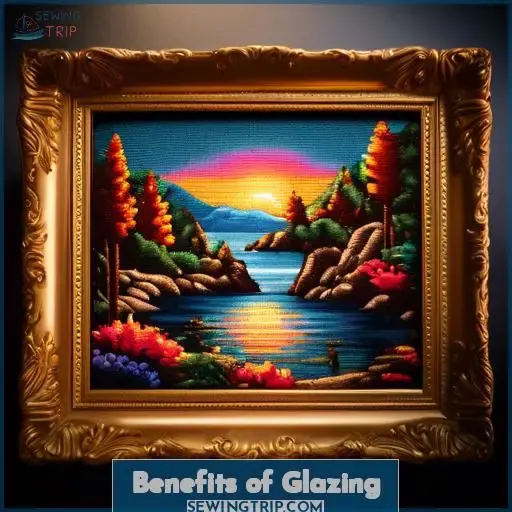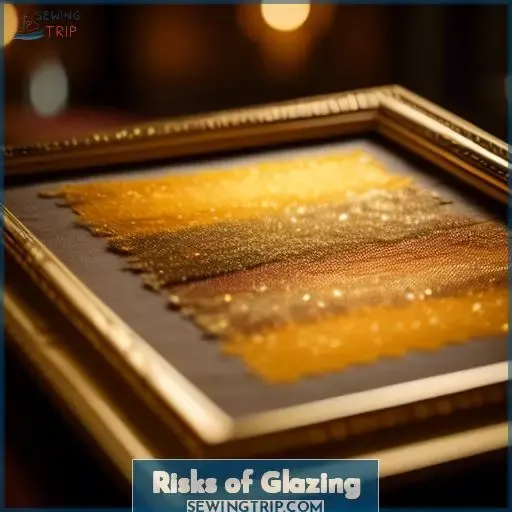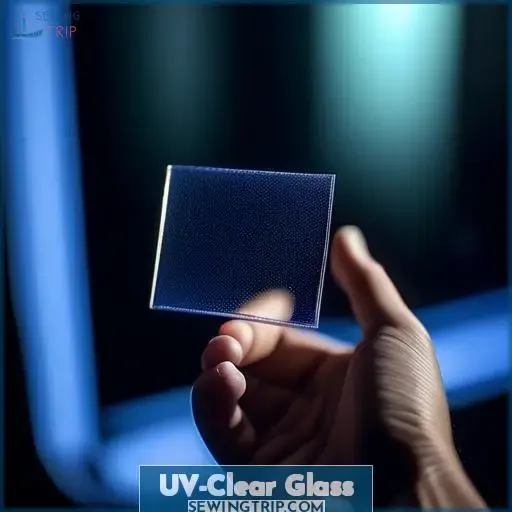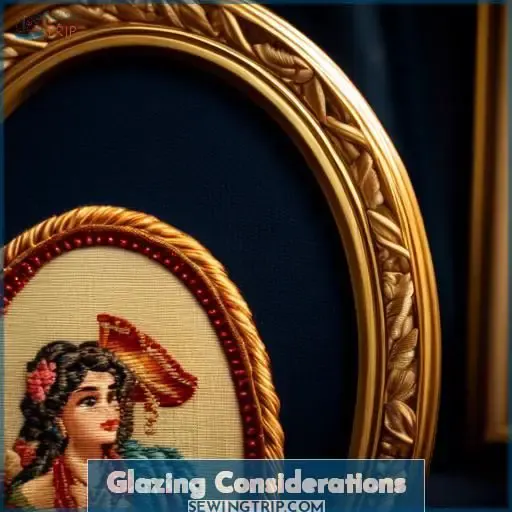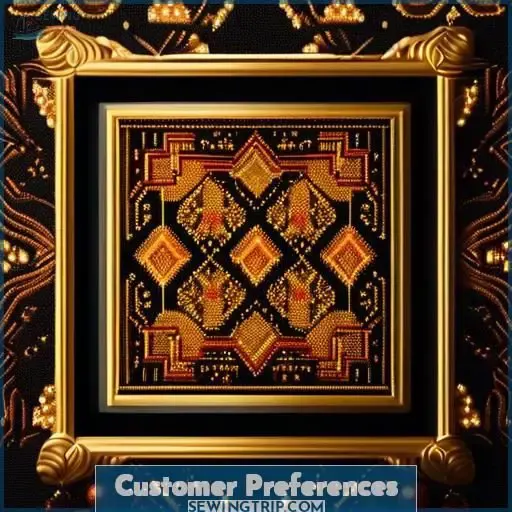This site is supported by our readers. We may earn a commission, at no cost to you, if you purchase through links.
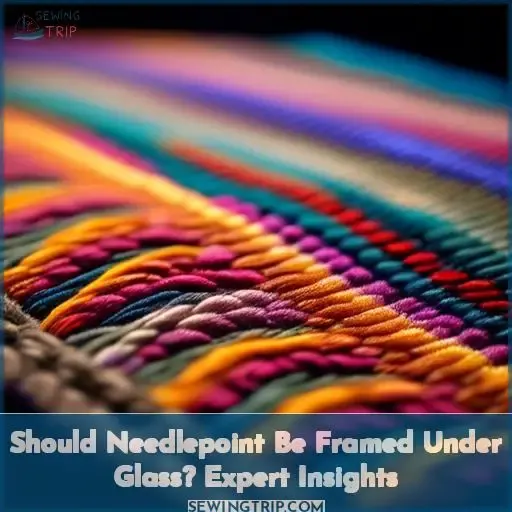
Dive into the liberating aspects of showcasing your needlepoint creations, the power you hold in choosing colors and techniques, and the mastery involved in perfecting your art.
Discover the benefits and risks of glazing your needlework, unraveling the secrets behind framing your needlepoint masterpieces with precision and care.
Table Of Contents
Key Takeaways
- UV protection: Glazing can prevent fading and enhance the beauty of needlepoint by providing excellent UV filtration, preventing ghosting and fading, and reducing condensation.
- Moisture damage prevention: Glazing can protect needlepoint from mold growth and moisture damage, which are common risks associated with natural fibers.
- Long-term preservation: Glazing can help maintain the appearance of needlepoint over time, ensuring long-term preservation.
- Customer preferences: Customers may prefer glazing for protection from dirt, dust, and insects, as well as for UV protection for animal-derived fibers.
Benefits of Glazing
When framing needlepoint, using glass offers UV protection, reduces glare, and prevents moisture damage, ensuring long-term preservation of the artwork. These benefits make glazing a valuable choice for protecting and enhancing the appearance of needlepoint pieces.
UV Protection Benefits
You’ve stitched your heart out, and now it’s time to shield your masterpiece from the sneaky fade of UV rays.
Think of UV-clear glass as your needlepoint’s knight in shining armor, warding off the UV light’s dulling spells.
With museum glass, your vibrant threads maintain their power, ensuring your art’s brilliance stands the test of time, a true testament to your mastery.
Glare Reduction Techniques
Glazing your needlepoint can significantly enhance the viewing experience by reducing glare and maintaining the vibrancy of colors.
Museum Glass, a type of glazing, is designed to minimize reflections and provide clear visibility, allowing you to appreciate the intricate details of your needlepoint.
By using glazing, you can protect your art from dust, insects, and fading, ensuring it remains in pristine condition for years to come.
Preventing Moisture Damage
Preventing moisture damage is a crucial aspect of framing needlepoint.
Glazing helps control humidity and regulates temperature changes within the frame, which in turn prevents condensation on the glass that can lead to mold or mildew growth.
By using a generous spacer between the glazing and the art, you can create space between the glass and the needlework, allowing for dimensional stitches and embellishments.
Additionally, mats, spacers, and liners can be used to create a barrier between the needlepoint and the glazing material, further preventing moisture damage.
Risks of Glazing
Glazing, the process of framing art with glass, can pose certain risks to needlepoint and other textile art. These risks include the deterioration of natural fibers, high risk of mold growth due to moisture condensation, and the transfer of images to the glass.
Natural fibers like wool can become closed in fibers, leading to deterioration, while moisture condensation can cause mold growth. The image transfer to the glass can also be a concern, especially for delicate needlework and cross stitch.
However, these risks can be mitigated with proper framing techniques, such as using a generous spacer between the glazing and the art, a solid backing board, and educating customers on the benefits and risks of glazing.
It’s essential to respect customer decisions, even if they decline glazing, as it isn’t only about preserving the art but also about the artist’s vision and the viewer’s experience.
UV-Clear Glass
When it comes to needlepoint framing, UV-clear glass is a game-changer. This type of glass is designed to provide excellent UV filtration, preventing ghosting and fading of your needlepoint art. It’s not merely a protective layer; it’s a robust solution that ensures your artwork stays vibrant for years to come.
One of the key benefits of UV-clear glass is its ability to prevent condensation, which can lead to mold or mildew growth. This is particularly important for needlepoint pieces that include natural fibers like silk or wool, which are susceptible to deterioration when exposed to moisture.
Moreover, UV-clear glass is a must-have for canvas art, which often requires advanced custom framing techniques to accommodate solid backings and environmental control. It’s an essential component of the framing process, underpinning the overall quality of the finished piece.
In the realm of needlepoint framing, UV-clear glass is a bespoke solution that tailors to the ever-evolving needs of the art world. It’s designed to enhance the beauty of your needlepoint, not only by preserving its colors but also by preventing fiber damage and image transfer.
So, when you’re navigating the complexities of needlepoint framing, remember that UV-clear glass is a crucial element of your suite of framing options.
Glazing Considerations
When considering whether to frame needlepoint under glass, it’s crucial to weigh the impact on natural fibers against the benefits of UV protection. Educating customers on these aspects ensures they make informed decisions tailored to their artwork’s needs.
Natural fibers and glazing
Framing needlepoint under glass can present certain challenges, particularly when using natural fibers like wool. The closed nature of these fibers may lead to deterioration due to moisture condensation, which can encourage mold growth and result in image transfer to the glass.
On the other hand, glazing offers several benefits. It provides protection from dirt, insects, and fading. Additionally, it can help regulate temperature and humidity changes within the frame, which can be beneficial for preservation.
To mitigate the risks associated with glazing, it’s recommended to use a generous spacer between the glazing and the art. This can help prevent moisture buildup and subsequent damage. Furthermore, a solid backing board can provide additional support and protection.
When discussing this option with customers, it’s important to educate them on both the benefits and risks. This will allow them to make an informed decision. Even if they decline glazing, it’s crucial to respect their decision and provide the best service possible.
UV protection benefits
UV protection is a key advantage of glazing needlepoint. This process filters out harmful UV rays, preventing fading and preserving the vibrant colors of your artwork.
Glazing also inhibits mold growth, maintaining the pristine condition of your piece. However, it’s crucial to educate customers about proper handling, correct hanging, and periodic inspections. These steps ensure the longevity of their needlepoint, particularly when dealing with natural fibers.
Customer education importance
Framing needlepoint requires careful consideration, and educating customers about their choices is essential. One crucial decision is whether or not to glaze the finished piece. Glazing offers several benefits, including protection from dust, dirt, and other airborne particles that can damage the delicate fibers.
Moreover, glazing can provide UV protection, which is particularly important for needlepoints made with animal-derived fibers like wool.
UV radiation can cause animal-derived fibers to deteriorate over time, leading to discoloration, brittleness, and overall degradation of the artwork. Glazing with a UV-protective material can significantly reduce the amount of UV radiation that reaches the needlepoint, helping to preserve its color and texture for years to come.
While glazing offers many benefits, it is not without risks. Glazing can create a barrier between the viewer and the artwork, making it more difficult to appreciate the texture and detail of the needlepoint.
Additionally, glazing can create glare, which can make it challenging to see the artwork in certain lighting conditions.
When deciding whether or not to glaze a needlepoint, customers should consider the artwork’s intended use and display. For example, a needlepoint that will be displayed in a sunny room may benefit from UV-protective glazing, while a piece that will be displayed in a low-light area may not require glazing at all.
Accepted framing techniques, such as those used by textile museums like Paul Frederick, can provide valuable guidance when making framing decisions. These techniques prioritize the preservation of the artwork while also considering the artist’s intentions and the viewer’s experience.
One framing technique that is often recommended for needlepoint is the use of foam center boards. These boards provide enhanced protection for the artwork, helping to prevent warping, bowing, and other types of damage.
Additionally, foam center boards can be used with or without glazing, providing customers with greater flexibility in their framing choices.
Ultimately, the decision to glaze a needlepoint is a personal one that should be based on the artwork’s intended use and display, as well as the customer’s preferences and the artist’s intentions. By considering all of these factors, customers can make informed decisions that will help preserve their needlepoint artwork for years to come.
Customer Preferences
When it comes to framing needlepoint, customers have their own preferences and risk tolerance, which can impact the final decision. Budget limitations and style preferences also play a significant role in the framing options chosen.
Customers may prefer not to glaze their needlepoint due to the risks associated with natural fiber deterioration, mold growth, and image transfer to the glass. However, others may opt for glazing to protect their work from dirt, insects, fading, and mechanical damage.
UV-Clear glass, in particular, is beneficial as it prevents ghosting and fading, requiring only 5-yearly inspections.
Educating customers on the benefits and risks of glazing is essential, allowing them to make informed decisions based on their preferences and needs. It’s crucial to respect their decisions, even if they decline glazing, as it ultimately reflects their personal style and budget limitations.
In some cases, customers may prefer unique framing options, such as floating frames with or without borders, gallery frames with or without mats, and deep-set gallery frames. These alternatives can showcase the details of the needlepoint piece and create a decorative display.
Considering customer perceptions, risk tolerance, budget limitations, and style preferences is vital when framing needlepoint. By understanding and respecting these factors, you can help customers make decisions that best suit their needs and preferences.
Frequently Asked Questions (FAQs)
What are the benefits of using UV-clear glass for needlepoint framing?
Using UV-clear glass for needlepoint framing offers several benefits. Firstly, it provides 99% UV protection, ensuring that colors stay vibrant and resist fading for many years. This is crucial for needlepoint pieces, as UV light can be damaging and cause colors to fade over time.
Additionally, UV-clear glass helps prevent insects from damaging the silk and wool fibers in needlepoint, as insects are attracted to these materials and can cause damage when they’re visible through the glass.
Furthermore, UV-clear glass eliminates reflections, making the artwork more enjoyable to view.
How should a solid backing board be used in needlepoint framing?
When it comes to framing needlepoint, the choice between glazing and not glazing is a complex one. On the one hand, glazing can protect the needlepoint from dirt, insects, and fading. It can also slow temperature and humidity changes within the frame, keeping the art clean and preventing mechanical damage.
However, it can also close natural fibers, causing deterioration, and increase the risk of mold growth due to moisture condensation. Additionally, glazing can transfer the image to the glass, which mightn’t be desirable for some needlepoint pieces.
On the other hand, not glazing can allow for more natural breathing of the needlepoint, as yarn doesn’t breathe like oil paintings. It can also prevent glare on the glass, which can detract from enjoyment. Museum Glass®, a type of non-glare glass, is clear and unobtrusive, reducing reflections and enhancing the viewing experience.
To frame a needlepoint piece without glazing, you can follow these steps:
- Clean and iron the needlepoint to remove any dirt or dust.
- Protect the needlepoint from sunlight, as UV light can fade colors.
- Use acid-free backing paper to protect the needlepoint from airborne contaminants.
- Extend the needlepoint beyond the frame to create a border.
- Ensure the frame complements the artwork, as it should enhance the piece rather than detract from it.
When it comes to the solid backing board, it’s essential to use a generous spacer between the glazing and the needlepoint. This spacer should be made of a solid material, such as a foam center board, to prevent the needlepoint from touching the glass.
Additionally, using a solid backing board can help protect the needlepoint from damage.
In conclusion, the decision to glaze or not glaze a needlepoint piece depends on the specific needs and preferences of the artist. It’s essential to consider the potential benefits and drawbacks of each option and make an informed decision based on the desired outcome.
What is the recommended distance between the glass and the needlepoint artwork?
When it comes to framing needlepoint, the recommended distance between the glass and the artwork depends on several factors. To ensure the longevity and protection of the needlepoint, it’s generally advisable to use glass.
Protection from insects and dirt: Glass protects needlepoint from insects, such as silverfish, which can damage the fibers, and from pollutants in the air that can soil the artwork.
UV protection: Glass offers 99% UV protection, which helps colors stay vibrant and resists fading for many years.
Glare reduction: Museum Glass® has a coating that virtually eliminates reflections, making it clear and unobtrusive.
Preventing glass contact damage: Condensation on the inside surface of the glass can lead to mold or mildew growth. To prevent this, use mats, spacers, fabric-wrapped liners, or other methods to create space between the glass and the needlepoint.
Customer preferences: Educate customers on the benefits and risks of glazing, respect their decisions, and provide them with options that suit their preferences.
In summary, it’s recommended to frame needlepoint under glass to protect it from insects, dirt, UV light, and potential damage from glass contact. However, it’s essential to follow best practices, such as using a generous spacer between the glass and the art, a solid backing board, and respecting customer decisions.
How often should needlepoint artwork be inspected for potential problems?
You should give your needlepoint artwork a once-over every five years for any sneaky issues. It’s like a health check-up for your art, ensuring it stays as vibrant and stunning as the day you framed it.
What are the advantages of using Museum Glass® for needlepoint framing?
Museum Glass® is an excellent choice for framing needlepoint art due to its numerous benefits.
UV Protection: Museum Glass® blocks up to 99% of UV rays, which can be damaging to needlepoint art and cause colors to fade over time.
Anti-Reflective: This type of glass eliminates reflections, ensuring that the colors and details of the needlepoint artwork are visible and not obscured by glare.
Dust and Dirt Protection: Museum Glass® provides a barrier against dust, pollutants, and other environmental factors that can damage the needlepoint over time.
Easier Cleaning: With Museum Glass®, you can simply wipe down the glass to clean the artwork, making it easier to maintain the piece.
Professional Appearance: Framing needlepoint behind Museum Glass® gives the artwork a polished, gallery-quality look that can enhance its overall presentation.
Transportation Durability: The glass adds extra strength and rigidity to the framed piece, making it more durable for transportation or handling.
In conclusion, Museum Glass® offers numerous benefits for framing needlepoint art, including UV protection, anti-reflective properties, dust and dirt protection, easier cleaning, a professional appearance, and increased durability during transportation.
Conclusion
Stepping into the tapestry of needlepoint framing, you hold the brush to paint your masterpiece’s future.
Deciding whether your needlepoint should be framed under glass is a nuanced choice. Glazing offers UV protection, reduces glare, and wards off moisture, safeguarding your art. However, weigh these benefits against potential risks and consider customer preferences.
Educating yourself on UV-clear glass and natural fiber considerations ensures your needlepoint remains a vibrant testament to your skill and passion.

